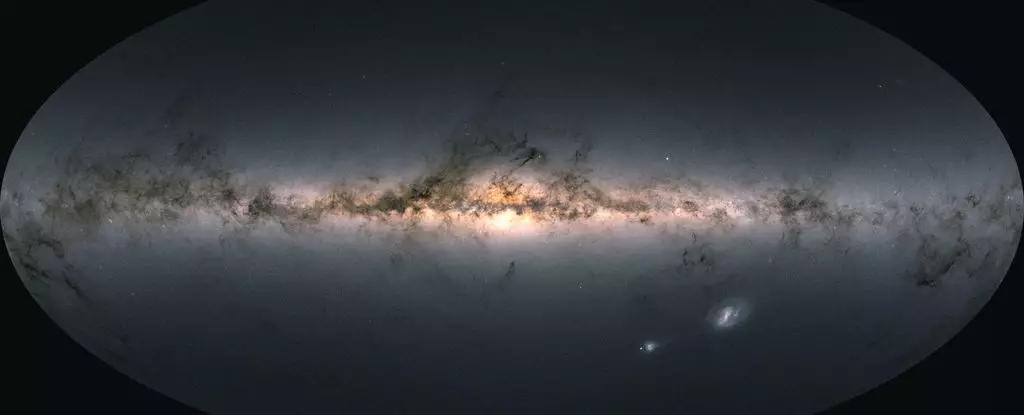As the universe expands and evolves, celestial bodies engage in a cosmic ballet that can lead to dramatic encounters. One of the most significant lessons learned from astronomical observation is that galaxies are not static; they are dynamic entities that interact, collide, and merge. Such an event is on the horizon for our Milky Way Galaxy as it begins a prolonged interaction with the Large Magellanic Cloud (LMC)—a dwarf galaxy that is not just a distant cosmic companion but also a harbinger of significance. Recently, astrophysicists have provided compelling evidence suggesting that a supermassive black hole, lurking within the LMC, could soon join the Milky Way in this grand collision. Their findings, led by Jiwon Jesse Han of the Harvard & Smithsonian Center for Astrophysics, offer a glimpse into the complicated relationships between galaxies and their hidden components.
The detection of a black hole estimated to have a mass approximately 600,000 times that of our Sun challenges previously held paradigms about the formation and evolution of these massive entities. Black holes, especially those of significant mass, have been a subject of fascination and intrigue in astrophysical research, primarily due to their elusive nature. They do not emit radiation that is easily detectable unless actively consuming material, which makes identifying them an arduous task. The black hole revealed in this study falls into an intriguing mass range that has been rarely encountered, complicating our understanding of how black holes transition from small star-sized masses into primarily gravitational giants.
The implications of confirming such a black hole’s existence extend beyond mere curiosity; it potentially enriches our comprehension of the lifecycle of black holes. This knowledge could help astrophysicists refine their models concerning how smaller black holes amalgamate over time, feeding off their surroundings and eventually merging with other black holes to become even more massive, perhaps analogous to the expected future merging of the black hole in the LMC and Sagittarius A*, the supermassive black hole at the Milky Way’s center.
To identify potential signs of the hidden black hole within the LMC, the researchers employed a novel approach that moved beyond traditional orbital analysis. Instead, the focus shifted to hypervelocity stars—objects that exhibit velocities surpassing the norm for stars within a galaxy. These stellar outliers are of exceptional interest because their rapid movements provide clues about the gravitational influences exerted upon them.
Utilizing data from the retired Gaia space telescope, which meticulously mapped the Milky Way’s celestial objects while analyzing their three-dimensional positions and velocities, the research team could trace the movements of 21 hypervelocity stars back to their origins. The focus was on the Hills mechanism, a phenomenon wherein interactions among stars and a black hole can propel a star to speeds allowing for escape from a galaxy. The evidence suggested that while some of these stars originated near Sagittarius A*, a substantial number were linked back to the LMC, implying that another massive gravitational influence—a black hole—was responsible for their accelerated trajectories.
The eventual merging of the Milky Way and the LMC is anticipated to occur in approximately two billion years. Although this may seem largely inconsequential on human timescales, the collision holds vast significance for astronomical studies. As these two galaxies interact, the hidden black hole residing within the LMC will journey toward the center of the Milky Way, ultimately culminating in a merger with Sagittarius A*. The anticipated growth of a more massive black hole from this cosmic union provides an exquisite opportunity to observe two black holes coalescing, a process critical to understanding black hole evolution.
This cosmic merge may redefine our perception of black holes and their roles in galactic ecology. It paints a vivid picture of how galactic structures can influence the evolution of terrestrial celestial bodies and offers a microcosm of cosmic phenomena as they unfold.
While the potential existence of this hidden black hole remains tentative, the avenues for further research are promising. Future observational efforts may either confirm its existence or refine the understanding of black holes and their behaviors. As technology advances, astronomers will have better tools to probe these enigmatic phenomena, contributing to our ever-evolving picture of the universe.
The looming dance of the Milky Way and the Large Magellanic Cloud is set against a backdrop of time that stretches far beyond human perception. Yet, the implications of such an event linger thoughtfully within the scientific community—reminding us that giants dwell quietly in the cosmos, waiting for moments of institutional revelation.

Leave a Reply